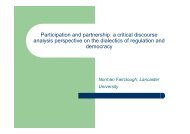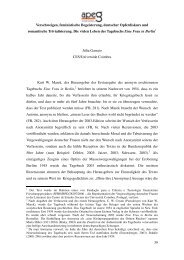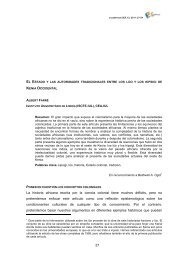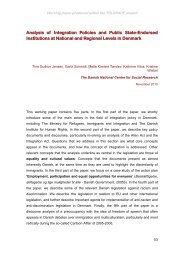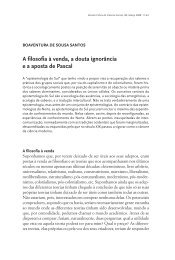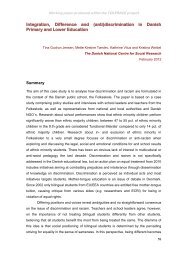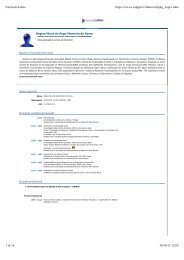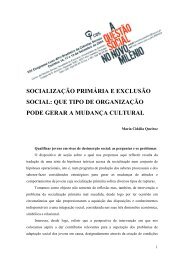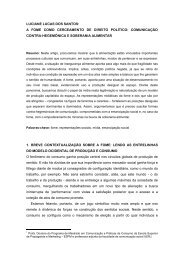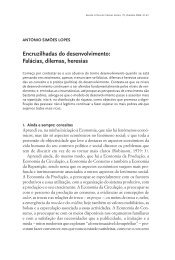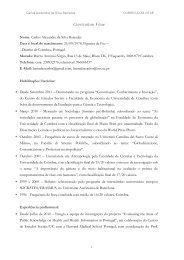The Instrumentalization of Sexual Violence in German Cold War Anti ...
The Instrumentalization of Sexual Violence in German Cold War Anti ...
The Instrumentalization of Sexual Violence in German Cold War Anti ...
You also want an ePaper? Increase the reach of your titles
YUMPU automatically turns print PDFs into web optimized ePapers that Google loves.
RCCS Annual Review, 5, October 2013<br />
<strong>The</strong> <strong>Instrumentalization</strong> <strong>of</strong> <strong>Sexual</strong> <strong>Violence</strong> <strong>in</strong> <strong>German</strong> <strong>Cold</strong> <strong>War</strong> <strong>Anti</strong>-Communist Discourses<br />
<strong>The</strong> image <strong>of</strong> Asia or the East as the embodiment <strong>of</strong> a barbarian, dangerous and cruel<br />
Other is a recurrent one <strong>in</strong> the construction <strong>of</strong> European and Western identities. After the<br />
October Revolution, Russia (and, eventually, the Soviet Union) emerged as a catalyst for<br />
fears, the Eastern “monster” <strong>in</strong>carnate, as anti-communism gradually took on orientalist<br />
connotations. Bolshevism and Communism were not viewed as European or Western<br />
phenomena, but rather as the hallmarks <strong>of</strong> an alien counter-model. <strong>The</strong> <strong>German</strong> territory<br />
provides a paradigmatic illustration <strong>of</strong> this mean<strong>in</strong>g <strong>of</strong> Bolshevik Russia as the <strong>in</strong>carnation <strong>of</strong><br />
the absolute Other (see, for <strong>in</strong>stance, Ayçoberry, 2003; Moore, 2003). <strong>The</strong>se phobias<br />
associated with anticommunism existed <strong>in</strong> several European countries. In <strong>German</strong>y they ran<br />
throughout the 20 th century, and spearheaded some <strong>of</strong> the more salient cont<strong>in</strong>uities<br />
between the Third Reich and the Federal Republic. Horrid images <strong>of</strong> sexual violence were<br />
common <strong>in</strong> this context, as attested to by anti-Bolshevik Nazi propaganda, which never<br />
stopped to frighten people with the “hordes <strong>of</strong> Soviet rapists,” especially <strong>in</strong> the last months<br />
<strong>of</strong> the war. 12 As noted by At<strong>in</strong>a Grossmann, this is exactly where propaganda proved<br />
om<strong>in</strong>ous. And that, <strong>in</strong> turn, helps us understand the impact <strong>of</strong> these National Socialist<br />
discourses and imag<strong>in</strong>aries upon <strong>German</strong>y’s memory <strong>of</strong> defeat, as well as the country’s selfperception<br />
as a people <strong>of</strong> victims (1995: 113-117, 1998: 221-24).<br />
<strong>The</strong> propaganda <strong>of</strong> Adenauer’s conservative era made blatant use <strong>of</strong> the traumatic<br />
experience <strong>of</strong> the rape <strong>of</strong> <strong>German</strong> women by members <strong>of</strong> the Red Army to justify some <strong>of</strong> its<br />
political positions, which expla<strong>in</strong>s its portray<strong>in</strong>g <strong>of</strong> the Soviet Union <strong>in</strong> terms <strong>of</strong> an<br />
aggressive, repellent mascul<strong>in</strong>ity. 13 Let us consider a 1952 poster <strong>of</strong> the Volksbund für<br />
Frieden und Freiheit [People’s Union for Peace and Freedom], an organization first<br />
established <strong>in</strong> 1949. It alludes to rape us<strong>in</strong>g it as a metaphor for <strong>German</strong>-Soviet friendship,<br />
(see, for <strong>in</strong>stance, the 1966 novel Westend, by Annemarie Weber, or Christian Graf von Krockow’s 1988<br />
account Die Stunden der Frauen. Nach e<strong>in</strong>er Erzählung Libussa Fritz von-Krockow [Hour <strong>of</strong> the Women. Based<br />
on an oral narrative by Libussa Fritz-Krockow]). Most <strong>of</strong> the studies on the treatment <strong>of</strong> this topic <strong>in</strong> the context<br />
<strong>of</strong> <strong>German</strong> culture focus on BeFreier und Befreite [Liberators Take Liberties], a documentary about rape <strong>in</strong> 1945<br />
Berl<strong>in</strong> by fem<strong>in</strong>ist filmmaker Helke Sander. Made <strong>in</strong> 1992, the film met both with great popular success and<br />
full-blown controversy.<br />
12 <strong>The</strong> phobia <strong>of</strong> the “hordes <strong>of</strong> Mongolian savages,” eager to murder, pillage, destroy and rape, had been one<br />
<strong>of</strong> the fears most fostered and exploited by the National Socialist authorities to mobilize people for the fight<br />
aga<strong>in</strong>st the Soviet <strong>of</strong>fensive, especially after the Nemmersdorf massacre (October 1944), when <strong>German</strong> women<br />
and girls were brutally raped and murdered. Regard<strong>in</strong>g the use <strong>of</strong> racist stereotypes for demoniz<strong>in</strong>g the Soviet<br />
Union <strong>in</strong> pre-1945 <strong>German</strong>y (not just <strong>in</strong> National Socialist circles) and the image <strong>of</strong> the rapist soldier <strong>in</strong> wartime<br />
propaganda, see, for example, Ayçoberry (2003: 455-65) and Moore (2003: 31-42).<br />
13<br />
Thumbnails <strong>of</strong> some <strong>of</strong> these posters can be seen at http://userpage.fuberl<strong>in</strong>.de/roehrigw/lva/ws9596/texte/kk/dhm/bsp.html.<br />
Retrieved March 8, 2012.<br />
50



